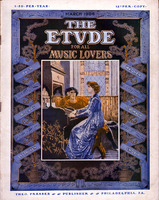The gullibility of the average collector of Italian violins is nothing less than amazing. In almost every large city, every town and every hamlet in the United States may be found some man of wealth whose greatest joy in life is his possession of a collection of old violins. In the majority of cases, these instruments are of little worth, commercially and from an artistic standpoint they are practically valueless. Yet the owners of such violins have paid enormous sums for their wretched “specimens,” and they innocently exhibit their “treasures” to the experienced fiddle-lover with the firm conviction that he, too, must necessarily marvel at the extraordinary beauties which such instruments are supposed to possess.
These collectors rarely play the violin. They know nothing about the art of violin making, either ancient or modern, except what they have gleaned from extravagantly written and unreliable books on the subject. They accept the plausible representations of some “reliable” firm as gospel truth, and lacking both the experienced eye and the sense of tone so essential in estimating the worth of a fiddle, they easily succumb to the blandishments of the cunning dealer, and gladly hand him a certified check for thousands of dollars for some toneless old wreck of a fiddle that was made in Italy a century or two ago.
We seriously doubt whether it would be possible to carry on such wholesale fraud as is being perpetrated today, if the alluring literature, spread broadcast every year, were entirely eliminated. This literature, in the form of books, pamphlets, brief articles, etc., is well calculated to mislead even the most intelligent amateurs, and to inflame the imagination of every gentleman of means who is anxious to possess a Cremona violin. It is pernicious literature, without one redeeming feature. Its readers assume that, on the whole, it is a presentation of facts; hence, the description of a Stradivari, its preservation, varnish, etc., is accepted as being truthful and accurate in all its essential features, and seemingly incredulous statements are regarded with no stronger suspicion than that they are slightly colored, as a natural result of enthusiasm, but unintentionally so.
But the truth of the matter is, that these descriptions too often furnish a solid basis for legal action. They are not merely misleading by implication; they positively state what is not true, and what can so easily be proven untrue. They speak, for instance, of the perfect state of preservation of a violin whose many cracks and scars are plainly visible to any normal eye. They rave about this remarkable state of preservation. Their cunning rhapsody is the sand that blinds the unsophisticated collector. The lie is incredibly bold, preposterous, but it succeeds where the simple, unvarnished truth would fail.
Now we do not imply, of course, that there are no honest men to be found among the dealers. Heaven forbid! We simply wish to warn amateur collectors against descriptions of violins that do not truthfully describe their worth and condition. Much of the current literature regarding violins is absolutely untrustworthy; but the average reader rarely questions the veracity of the writer, and the enthusiastic but ignorant collector joyfully exchanges his check for an undesirable Italian fiddle on the strength of an unconscientious dealer’s representations.
When we read the descriptive tommy-rot that is offered intelligent men for perusal and digestion, we are strongly reminded of the incomparable Mark Twain (“Innocents Abroad”), when he asks:
“What would you think of a man who gazed upon a dingy, foggy sunset and said: ‘What sublimity, what feeling, what richness of coloring!’ What would you think of a man who stared in ecstasy upon a desert of stumps and said: ‘Oh, my soul, my beating heart, what a noble forest is here!’ “You would think that those men had an astonishing talent for seeing things that had already passed away.”



